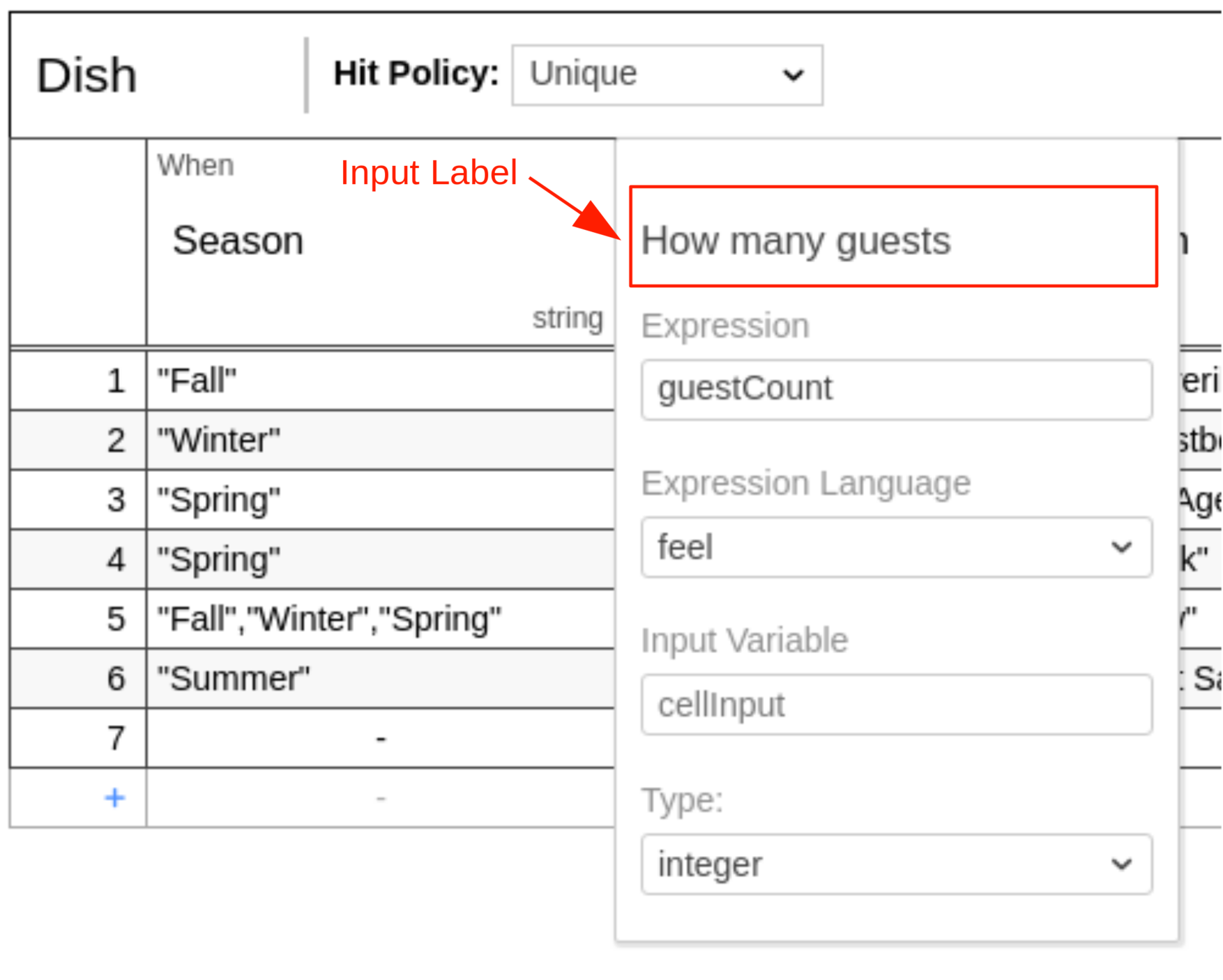DMN Decision Table Input

A decision table can have one or more inputs, also called input clauses. An input clause defines the id, label, expression and type of a decision table input.
An input can be edited by double-clicking on the respective colum header in the decision table.
An input clause is represented by an input element inside a decisionTable
XML element.
<definitions xmlns="https://www.omg.org/spec/DMN/20191111/MODEL/" id="definitions" name="definitions" namespace="http://camunda.org/schema/1.0/dmn">
<decision id="dish" name="Dish">
<decisionTable id="decisionTable">
<input id="input1" label="Season">
<inputExpression id="inputExpression1" typeRef="string">
<text>season</text>
</inputExpression>
</input>
<!-- ... -->
</decisionTable>
</decision>
</definitions>
Input Id
The input id is a unique identifier of the decision table input. It is used by
Camunda 7 to reference the input in the history of evaluated
decisions. Therefore, it is required by the Camunda DMN engine. It is set as
the id attribute of the input XML element.
<input id="input1" label="Season">
<inputExpression id="inputExpression1" typeRef="string">
<text>season</text>
</inputExpression>
</input>
Input Label

An input label is a short description of the input. It is set on the input
XML element in the label attribute. Note that the label is not required but
recommended, since it helps to understand the decision.
<input id="input1" label="Season">
<inputExpression id="inputExpression1" typeRef="string">
<text>season</text>
</inputExpression>
</input>
Input Expression

An input expression specifies how the value of the input clause is generated.
It is an expression which will be evaluated by the DMN engine. It is usually
simple and references a variable which is available during the evaluation. The
expression is set inside a text element that is a child of the
inputExpression XML element.
<input id="input1" label="Season">
<inputExpression id="inputExpression1" typeRef="string">
<text>season</text>
</inputExpression>
</input>
Input Type Definition

The type of the input clause can be specified by the typeRef attribute on the
inputExpression XML element. After the input expression is evaluated by the
DMN engine, it converts the result to the specified type. The supported types
are listed in the User Guide.
<input id="input1" label="Season">
<inputExpression id="inputExpression1" typeRef="string">
<text>season</text>
</inputExpression>
</input>
Note that the type is not required but recommended, since it helps to understand the possible input values and provides a type safety to be aware of unexpected input values.
Input Expression Language
The expression language of the input expression can be specified by the
expressionLanguage attribute on the inputExpression XML element. The
supported expression languages are listed in the User Guide.
<input id="input1" label="Season">
<inputExpression id="inputExpression1" typeRef="string" expressionLanguage="groovy">
<text>season</text>
</inputExpression>
</input>
If no expression language is set then the global expression
language, which is set on the definitions XML element, is used.
<definitions id="definitions"
name="definitions"
xmlns="https://www.omg.org/spec/DMN/20191111/MODEL/"
expressionLanguage="groovy"
namespace="http://camunda.org/schema/1.0/dmn">
<!-- ... -->
</definitions>
In case no global expression language is set, the default expression language is used instead. The default expression language for input expressions is JUEL. Please refer to the User Guide to read more about expression languages.
Input Variable Name
When the input expression is evaluated then the return value is stored in a variable.
The name of the variable can be specified by the camunda:inputVariable
extension attribute on the input element. By default, the
name is cellInput.
To use the attribute you have to define the Camunda DMN namespace
xmlns:camunda="http://camunda.org/schema/1.0/dmn in the XML.
<definitions id="definitions"
name="definitions"
xmlns="https://www.omg.org/spec/DMN/20191111/MODEL/"
xmlns:camunda="http://camunda.org/schema/1.0/dmn"
namespace="http://camunda.org/schema/1.0/dmn">
<decision id="dish" name="Dish">
<decisionTable id="decisionTable">
<input id="input1"
label="Season"
camunda:inputVariable="currentSeason">
<!-- ... -->
</input>
<!-- ... -->
</decisionTable>
</decision>
</definitions>
The variable can be used in an expression of an input entry. For example, the
JUEL expression currentSeason != "Fall" checks if the season input is not
"Fall".